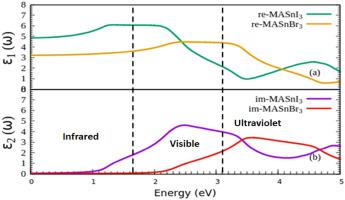当前位置:
X-MOL 学术
›
Mater. Chem. Phys.
›
论文详情
Our official English website, www.x-mol.net, welcomes your
feedback! (Note: you will need to create a separate account there.)
Computational determination of the physical-thermoelectric parameters of tin-based organomatallic halide perovskites (CH3NH3SnX3, X = Br and I): Emerging materials for optoelectronic devices
Materials Chemistry and Physics ( IF 4.3 ) Pub Date : 2020-10-01 , DOI: 10.1016/j.matchemphys.2020.123389 Akash Shukla , Vipan Kumar Sharma , Saral Kumar Gupta , Ajay Singh Verma
Materials Chemistry and Physics ( IF 4.3 ) Pub Date : 2020-10-01 , DOI: 10.1016/j.matchemphys.2020.123389 Akash Shukla , Vipan Kumar Sharma , Saral Kumar Gupta , Ajay Singh Verma

|
Abstract The promising material hybrid Organic-Inorganic Perovskites (HOIP) has been frequently a subject of comprehensive and intensive experimental and theoretical studies. As Because of noxiousness and longtime environmental stability of heavy metal lead, since last few years non-lead based perovskites compounds either organic or inorganic are attracting attention in the solar cell formation. In this work, we have studied the fundamental properties of CH3NH3SnI3 and CH3NH3SnBr3 like structural, electronic, optical and thermoelectric. We have been used full-potential linearized augmented plane wave method (FP-LAPW) within density functional theory (DFT) and implement it in Wien2k. The generalized gradient approximation (GGA) of Perdew–Burke–Ernzerhof (PBE) for the exchange-correlation functional has been used to relax the structural parameters of these materials. The electronic properties have been evaluated by using different GGA and LDA (Local density approximation) exchange correlation potential. We have obtained the values of band gap 1.172 eV and 1.902 eV for CH3NH3SnI3 and CH3NH3SnBr3 respectively by TB-mBJ exchange-correlation potential. According the optical properties, we have seen that because of high absorption coefficient of CH3NH3SnI3 and CH3NH3SnBr3perovskites, they may be strongly applied in photovoltaic device for the visible to ultra-violet wavelength region. Thermoelectric properties have shown that at room temperature they also may be used as thermoelectric device. Based on my knowledge, the investigations on tin based perovskites have been discussed for first time.
中文翻译:

计算测定锡基有机金属卤化物钙钛矿(CH3NH3SnX3,X = Br 和 I)的物理热电参数:光电器件的新兴材料
摘要 有前途的材料杂化有机-无机钙钛矿 (HOIP) 经常成为全面而深入的实验和理论研究的主题。由于重金属铅的毒性和长期环境稳定性,近年来非铅基钙钛矿化合物无论是有机的还是无机的,在太阳能电池的形成中都引起了人们的关注。在这项工作中,我们研究了 CH3NH3SnI3 和 CH3NH3SnBr3 的基本性质,如结构、电子、光学和热电。我们已经在密度泛函理论 (DFT) 中使用了全电位线性化增强平面波方法 (FP-LAPW),并在 Wien2k 中实现了它。用于交换相关泛函的 Perdew-Burke-Ernzerhof (PBE) 的广义梯度近似 (GGA) 已用于放宽这些材料的结构参数。电子特性已通过使用不同的 GGA 和 LDA(局部密度近似)交换相关势进行评估。我们通过 TB-mBJ 交换相关电位分别获得了 CH3NH3SnI3 和 CH3NH3SnBr3 的带隙值 1.172 eV 和 1.902 eV。根据光学性质,我们已经看到,由于 CH3NH3SnI3 和 CH3NH3SnBr3 钙钛矿的高吸收系数,它们可以在可见光到紫外波段的光伏器件中得到很好的应用。热电特性表明,在室温下它们也可以用作热电器件。根据我的知识,
更新日期:2020-10-01
中文翻译:

计算测定锡基有机金属卤化物钙钛矿(CH3NH3SnX3,X = Br 和 I)的物理热电参数:光电器件的新兴材料
摘要 有前途的材料杂化有机-无机钙钛矿 (HOIP) 经常成为全面而深入的实验和理论研究的主题。由于重金属铅的毒性和长期环境稳定性,近年来非铅基钙钛矿化合物无论是有机的还是无机的,在太阳能电池的形成中都引起了人们的关注。在这项工作中,我们研究了 CH3NH3SnI3 和 CH3NH3SnBr3 的基本性质,如结构、电子、光学和热电。我们已经在密度泛函理论 (DFT) 中使用了全电位线性化增强平面波方法 (FP-LAPW),并在 Wien2k 中实现了它。用于交换相关泛函的 Perdew-Burke-Ernzerhof (PBE) 的广义梯度近似 (GGA) 已用于放宽这些材料的结构参数。电子特性已通过使用不同的 GGA 和 LDA(局部密度近似)交换相关势进行评估。我们通过 TB-mBJ 交换相关电位分别获得了 CH3NH3SnI3 和 CH3NH3SnBr3 的带隙值 1.172 eV 和 1.902 eV。根据光学性质,我们已经看到,由于 CH3NH3SnI3 和 CH3NH3SnBr3 钙钛矿的高吸收系数,它们可以在可见光到紫外波段的光伏器件中得到很好的应用。热电特性表明,在室温下它们也可以用作热电器件。根据我的知识,











































 京公网安备 11010802027423号
京公网安备 11010802027423号